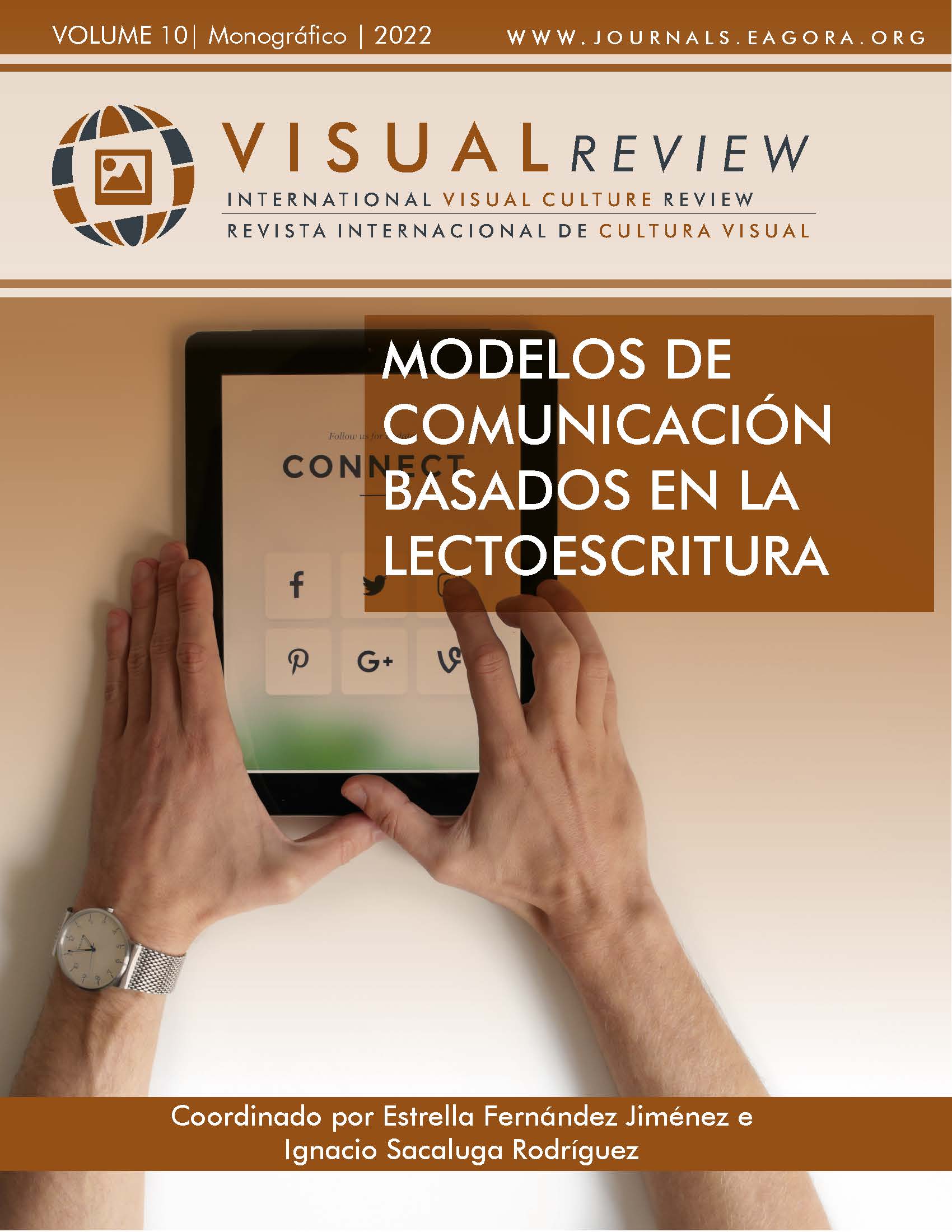The Audiovisual Proposal as a Reflection of the Influence of Social Networks on Young People
Nerve’s case
DOI:
https://doi.org/10.37467/revvisual.v9.3604Keywords:
Social Netwoks, Assumption of roles, Youths, Online Platforms, Nerve, Audiovisual, CinemaAbstract
The behavioral tendencies of young people in the use of social networks sometimes lead to a certain assumption of roles. This fact is supported by several well-known studies. The audiovisual field, as an echo of our society, drives us to a deep reflection and also warns about the impact of the digital environment on the youth community. The purpose of this article is to address the analysis of this situation from a communicative point of view referred to the American film Nerve (2016), based on the novel ¨Nerve, a game without rules¨ written by Jeanne Ryan.
Downloads
Global Statistics ℹ️
|
905
Views
|
702
Downloads
|
|
1607
Total
|
|
References
Aguirre, J. L. (2011). Introducción al análisis de redes sociales. Documentos de Trabajo del Centro Interdisciplinario para el Estudio de Políticas Públicas, 82(2), 1-59.
Berger, J. y Milkman, K.L. (2012). What makes online content viral? Journal of Marketing Research, 49, pp. 192-205. DOI: https://doi.org/10.1509/jmr.10.0353
Colás-Bravo, P., González-Ramírez, T., y de-Pablos-Pons, J. (2013). Juventud y redes sociales: Motivaciones y usos preferentes. Comunicar, 40, 15-23. https://doi.org/10.3916/C40-2013-02-01 DOI: https://doi.org/10.3916/C40-2013-02-01
De la Fuente Prieto, J., Lacasa Díaz , P., y Martínez-Borda, R. (2019). Adolescentes, redes sociales y universos transmedia: la alfabetización mediática en contextos participativos. Revista Latina De Comunicación Social, 74, 172-196. https://doi.org/10.4185/RLCS-2019-1326 DOI: https://doi.org/10.4185/RLCS-2019-1326
García Galera, M.d.C, Del Olmo Barbero, J. y Del Hoyo Hurtado, M. (2018). Jóvenes, privacidad y dependencia en las redes sociales. El II Congreso Internacional Move.net sobre Movimientos Sociales y TIC (128-138), Sevilla: Grupo Interdisciplinario de Estudios en Comunicación, Política y Cambio Social de la Universidad de Sevilla.
Gordo López, Ángel Juan (2008) ¿Jóvenes en peligro o peligrosos?: alarmas y tecnologías sociales del «desarrollo» y gobierno digital. Revista de estudios de juventud, 82. (pp. 103-114).
Jiménez Cruz, Sergio, (2008). La dimensión ética del cine de ciencia ficción. Konvergencias, Filosofía y Culturas en diálogo, 17. Abril (pp. 106-116)
Marañón, Carlos Oliva (2012). Redes sociales y jóvenes: una intimidad cuestionada en internet. Aposta. Revista de Ciencias Sociales, (54),1-16. Disponible en:
https://www.redalyc.org/articulo.oa?id=495950250003
Martín Critikián, D. y Medina Núñez, M. (2021). Redes sociales y la adicción al like de la generación z. Revista de Comunicación y Salud: RCyS, 11. (pp. 55-76) DOI: https://doi.org/10.35669/rcys.2021.11.e281
Mckee, R. (2009). El guion: sustancia, estructura, estilo y principios de la escritura de guiones. Barcelona: Alba
Peralta Rodríguez, Misael (2020) Cine y redes sociales: la transformación de la mirada en la pantalla. En Alvarado Duque, Carlos Fernando (2020) Estética, sociedad y cine: re-interpretando el séptimo arte. Ed. Manizales: Fondo Editorial Universidad de Manizales, Facultad de Ciencias Sociales y Humanas. (Escuela de Comunicación Social y Periodismo. Colección de libros Escribanía) (pp. 79-103)
Ryan, J. (2016), Nerve: un juego sin reglas, Estados Unidos, Editorial Alfaguara.
Sanz Menéndez, L. (2003). Análisis de redes sociales: o como representar las estructuras sociales subyacentes. Apuntes e Ciencia y Tecnología, Nº7, pp. 21-29.
Stornaiuolo, A., DiZio, J., & Hellmich, E. (2013). Expanding community: Youth, social networking and schools. [Desarrollando la comunidad: jóvenes, redes sociales y escuelas]. Comunicar, 40, 79-88. https://doi.org/10.3916/C40-2013-02-08 DOI: https://doi.org/10.3916/C40-2013-02-08
Villanueva Prieto, Dario. (2020). Postverdad y distopía. Revista de estudios literarios, 10 (pp. 673-695) DOI: https://doi.org/10.14195/2183-847X_10_34
Vogler, C. (2002). El viaje del escritor. Barcelona: Manontroppo.
Filmografía
Amer, K. y Noujaim, J. (2019) [Documental] El gran hackeo. Netflix
Boyle, D. (2015). Steve Jobs. [Película] Mark Gordon Company, Scott Rudin Productions, Universal Pictures, Legendary Pictures.
Burke, M. (1999) Piratas de Silicon Valley [Telefilm] TNT.
Fincher, D. (2010). The social Network. [Película] Sony.
Franmar, A. (2021) 7 días sin redes sociales [Película] Máximo Project Studio.
Joost, H y Schulman, A. (2016). Nerve. [Película] Lionsgate, Allison Shearmur Productions, Keep Your Head Productions, Supermarché.
Orlowski, J. (2020) [Documental] El dilema de las redes sociales. Argent Pictures, Exposure Labs, The Space Program. Distribuidora: Netflix
Pondsoldt, J. (2017). The Circle. [Película] Imagenation Abu Dhabi FZ, Likely Story, Parkes+MacDonald Image Nation.
Stone, O. (2016). Snowden [Película] Open Road Films, Endgame Entertainment.
Downloads
Published
How to Cite
Issue
Section
License
Those authors who publish in this journal accept the following terms:
-
Authors retain copyright.
-
Authors transfer to the journal the right of first publication. The journal also owns the publishing rights.
-
All published contents are governed by an Attribution-NoDerivatives 4.0 International License.
Access the informative version and legal text of the license. By virtue of this, third parties are allowed to use what is published as long as they mention the authorship of the work and the first publication in this journal. If you transform the material, you may not distribute the modified work. -
Authors may make other independent and additional contractual arrangements for non-exclusive distribution of the version of the article published in this journal (e.g., inclusion in an institutional repository or publication in a book) as long as they clearly indicate that the work was first published in this journal.
- Authors are allowed and recommended to publish their work on the Internet (for example on institutional and personal websites), following the publication of, and referencing the journal, as this could lead to constructive exchanges and a more extensive and quick circulation of published works (see The Effect of Open Access).













